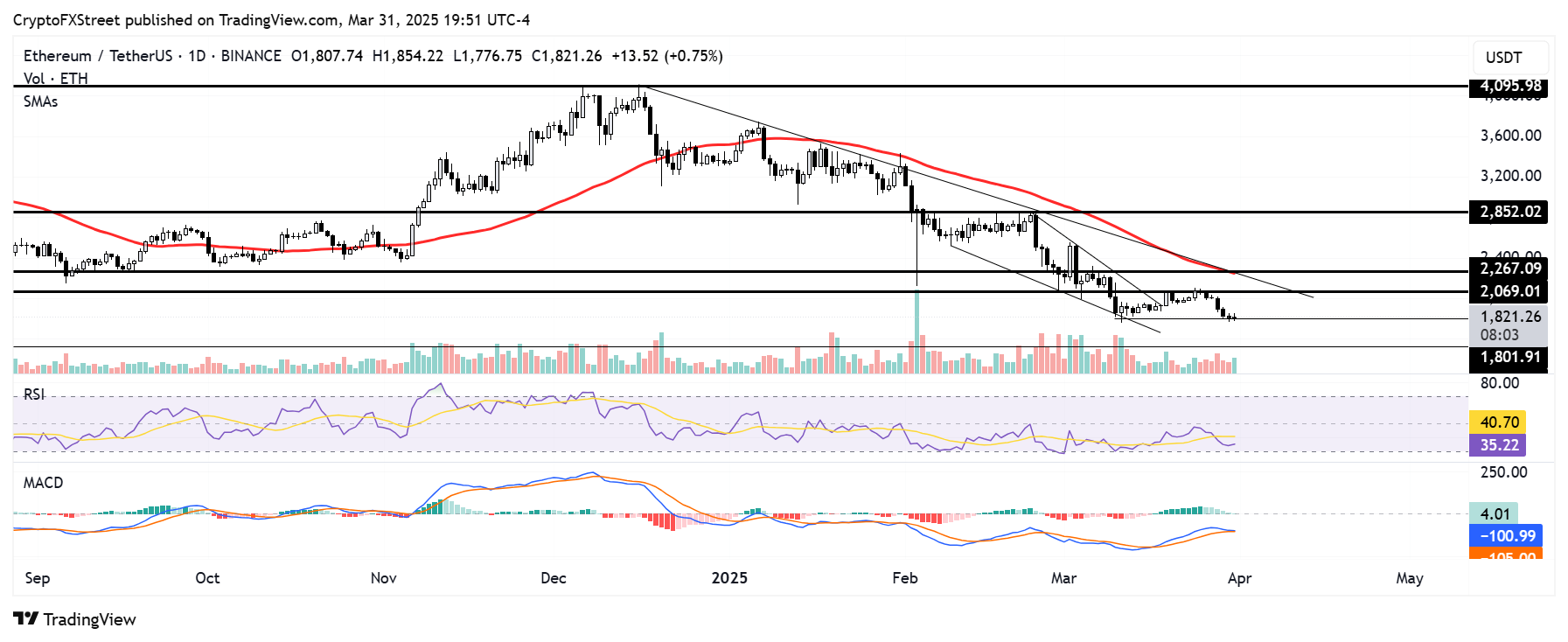Current Ethereum Price: $1,820
- Short-term holders of Ethereum have capitulated, incurring $400 million in losses in response to heightened risk-averse sentiment following President Trump’s announcement of reciprocal tariffs.
- Despite this capitulation, data on ETH exchanges and staking trends suggest that most investors maintain a bullish perspective.
- If ETH fails to stay above the $1,800 level, it may face additional downward pressure.
Ethereum (ETH) rebounded from the $1,800 support level on Monday amidst increased sell-offs from short-term holders and concerns surrounding President Donald Trump’s planned tariffs, set to take effect on April 2. While there’s a cautious outlook in the short term, dwindling ETH reserves on exchanges and rising staking balances could provide price support.
Ethereum Short-Term Holders Realize $400 Million in Losses Amid Rising Staking Activity
Short-term holders of Ethereum are showing a growing inclination to avoid risk as uncertainty looms over how the price may react to “Liberation Day” on April 2, when Trump intends to enforce reciprocal tariffs and hike duties on US trade partners.
Frequent increases in the Dormant Circulation metric indicate that short-term holders, particularly those whose coins were last moved between three to six months ago, ramped up their selling in March.
ETH dormant circulation
In recent hours, these holders have further increased their distribution, leading some to sell at a loss, as indicated by the Network Realized Profit/Loss metric. On Monday, it was reported that recent sellers accounted for nearly $400 million in losses.
Similar instances of realized losses can be seen throughout March, highlighting capitulation from many short-term holders, who contributed significantly to the distribution during the month. Historically, a market bottom is often found following the thorough selling from this group. However, a continuation of the downtrend could occur if long-term holders start to sell as well.
ETH realized profit/loss
Meanwhile, investors holding between 1K to 10K ETH have ramped up their selling over the last two weeks, reducing their overall balance by 160K ETH. This trend may be driven by ETH’s prolonged downtrend, as this group had been increasing their holdings since January until recently.
Conversely, larger investors holding between 10K to 100K ETH increased their balances by 290K ETH over the weekend, showcasing a divergence in sentiment between these two groups of investors.
ETH supply distribution
This shift comes as ETH exchange reserves remain low, following the withdrawal of 940K ETH over the month. Many of those funds likely transitioned to staking protocols, as ETH’s total staked value surged by around 530K ETH in the last three weeks. This trend reflects a preference for long-term holding, even with declining prices.
ETH total value staked
Ethereum Price Outlook: A Bearish Continuation Could Occur if $1,800 Fails to Hold
In the last 24 hours, Ethereum experienced $63.18 million in futures liquidations, as per recent data. This includes liquidated long positions totaling $37.33 million and short positions at $25.85 million.
ETH bounced back from the $1,800 level after declining over 10% from Friday to the weekend. This occurred after ETH broke out of a falling wedge pattern but faced rejection at the $2,070 resistance last week. A bullish scenario remains possible as long as buying interest holds near the $1,800 level.
ETH/USDT daily chart
A breakout above $2,070, along with overcoming the key descending trendline resistance from December 16, would confirm a bullish trend. However, this resistance level could present a significant obstacle as it is further reinforced by the 50-day Simple Moving Average (SMA).
On the flip side, ETH may confirm a bearish trend if it sustains a drop below $1,800, potentially finding support at $1,500.
The Relative Strength Index (RSI) is currently below neutral territory, while the Moving Average Convergence Divergence (MACD) line is testing its average line, with histogram bars nearing a negative crossover. Such a crossover could amplify downside pressure.
Ethereum FAQs
Ethereum is a decentralized, open-source blockchain that supports smart contracts. Its native currency, Ether (ETH), ranks as the second-largest cryptocurrency and leads in market capitalization among altcoins. The Ethereum network facilitates the development of a wide range of crypto solutions, including decentralized finance (DeFi), GameFi, non-fungible tokens (NFTs), and decentralized autonomous organizations (DAOs).
Ethereum is a public, decentralized blockchain that enables developers to create applications functioning without a central authority. To facilitate this, it utilizes the Solidity programming language and the Ethereum Virtual Machine, aiding developers in creating and launching applications featuring smart contract capabilities.
Smart contracts are codes that automate agreements between parties and are publicly verifiable. These codes execute pre-defined actions automatically when specified conditions are met.
Staking involves earning rewards on dormant cryptocurrencies by locking them in a protocol for a specific duration to contribute to its security. Ethereum transitioned from a Proof-of-Work (PoW) to a Proof-of-Stake (PoS) consensus mechanism on September 15, 2022, in a pivotal event termed “The Merge.” This change aimed to enhance Ethereum’s scalability, decentralization, and security while ensuring sustainability. Unlike PoW, which requires costly hardware, PoS lowers the entry barrier for validators by relying on cryptocurrency tokens for consensus.
Gas represents the unit of measure for transaction fees users incur when carrying out transactions on Ethereum. During times of network congestion, gas fees can rise significantly, leading validators to prioritize transactions based on their associated fees.

 [00.27.58, 01 Apr, 2025]-638790631847374826.png)
 [00.28.06, 01 Apr, 2025]-638790632274074674.png)
-638790632629395236.png)
